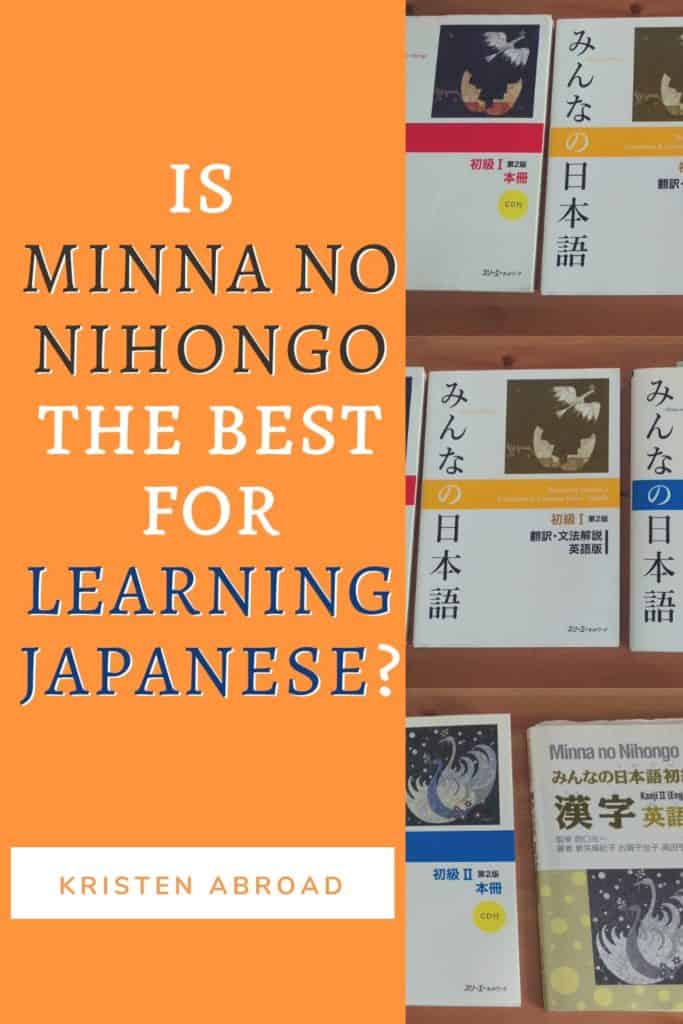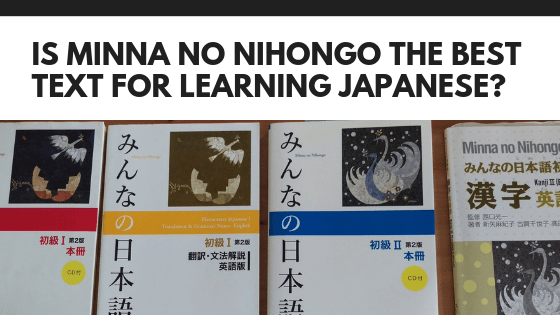Whereas the internet and apps seem to have taken over the language learning world, there is still a strong case for a clear and concise course in text. Having an organized path is beneficial to the learning process. Possibly one of the best textbooks in the world for learning Japanese is Minna no Nihongo (みんなの日本語).
First lesson: Minna or 皆, means “everyone”. Therefore, the title of the series means, “Japanese for everyone”.
- A Language Series for the People
- Is it really for everyone?
- Why the second edition?
- Minna no Nihongo (みんなの日本語): Start with the basics
- What to expect with the Main Text (本冊) of Minna No Nihongo
- YES! There is an answer key
- What’s in the Translation and Grammar Notes?
- Time Required
- Can I use this to study for the JLPT?
- Cons of Minna No Nihongo
- Pros of Minna No Nihongo
- Self Studying?
- Supplementary Books
- Where to find the Minna No Nihongo books
- Other available options
- Is it the best?
- Pin this for Later
A Language Series for the People
Fun fact? The Minna Series (abbreviation, it’s how we roll) is actually adapted from a different language series.
Shin Nihongo no Kiso is a series known for it’s learning methodology written in the early 1990s but is aimed at engineers. By trade, I’m an engineer so apparently, I should be promoting the Shin Series!
While nearly identical, the dividing factor was whom the study material was aimed at. The vocabulary in the Shin Nihongo no Kiso series is highly technical. Minna no Nihongo is for more general learning.
Is it really for everyone?
While it is excellent beginner-level material, Minna no Nihongo (みんなの日本語) is not for the faint of heart (more on that soon). However, it is one of the most used Japanese language texts in Japan as it was set up to be used by Japanese speaking teachers (or sensei, 先生). It is the textbook series that Japanese conversation classes in Yokosuka use as well as other private tutors.
If you are taking a conversation class in Japan, it’s highly likely this will be your course material. Colleges in the states tend to use “Genki: An Integrated Course in Elementary Japanese”, or more commonly referred to as “Genki”, while also instructional, many language learners prefer Minna.
Why the second edition?
First things first, there are two editions, you want the second! (I’ll give you links below). Why am I bringing this up? Well, one, it can be slightly confusing if you try and look up anything about Minna no Nihongo online by yourself, there are a LOT of different materials. (I’m speaking from experience). Two, it’s an improvement.
The first edition books (本冊) are split into beginner (初級,
However, one thing hasn’t changed and that is that you will require a second “Translation and Grammatical Notes” book for each level. Why? Because the text is SOLELY in Japanese. The grammar notes are translated separately into 13 different languages: English, Chinese, Korean, Spanish, Portuguese, French, Thai, Indonesian, Russian, German, Vietnamese, Italian, and Burmese.
Minna no Nihongo (みんなの日本語): Start with the basics
Being the main text is solely in Japanese, it greatly helps to already have a working knowledge of hiragana and katakana. The first section of the text includes charts, you’ll have to move over to the translation text for pronunciations though.
If you speak English (you’re reading an English site, so that’s a good assumption on my part), there are romanized versions of both levels as well but I recommend staying away from the crutch that gives you.
What to expect with the Main Text (本冊) of Minna No Nihongo
There are 25 chapters or lessons, each building on the previous. Total of 50 chapters between both books. You’ll be introduced to a cast of characters. Get ready to follow their journey and experiences in Japan through your learning. Within each lesson, you’ll have the following:
- Vocabulary
- Sentence patterns
- Example sentences
- Conversation
- Three levels of exercises: one to help you to understand the grammatical structure; the second helps with patterns; third is to help with conversation abilities.
- Practice questions (if you were in a graded class, call it the quiz section)
YES! There is an answer key
In an earlier version of this article, I had stated that I was unaware if there was an answer key or not. Early in my Japanese learning, I hadn’t noticed it in the back of the main textbook. The section gives you answers to all Exercise B and C questions from each chapter.
This is a plus over other Japanese language textbooks like Genki. To find the answers with Genki, you must purchase a separate answer key book. I want to say this is indicative of it being part of the American education system but it could also be just for the fact that the company gets more money!
What’s in the Translation and Grammar Notes?
Some may think to require a second book to be tedious. Though, even as a pair, it is still quite inexpensive. However, the nice thing about using this series? Remember how it is translated into 13 languages? Immersion-style is the best way to learn.
Teachers may speak English as needed, however, some of the students might be Chinese, Vietnamese, etc. A teacher, therefore, can teach any number of students without themselves having a full grasp on the students’ native tongue.
Along with a translation and explanation of all the lesson material, you will also find general explanations of the Japanese writing system and pronunciations, as well as counter suffixes (the bane of Japanese learning!) and conjugations of verbs.
Time Required
The writers suggest it will take between 4-6 hours to be proficient at each chapter. That equates to 300 hours for both levels. That seems like a lot (one hour a day = 10 months for beginning Japanese?!) but it goes with anything, if it is something you are passionate about, you’ll find ways to carve out pieces of your day to fit it in.
Can I use this to study for the JLPT?
Of course! Though I haven’t been able to find a direct comparison, you should definitely be able to use this to study for the N5/N4 test for the Japanese Language Proficiency Test. I’d highly recommend the additional use of the Kanji supplement text to help with that portion of the test. Add Minna no Nihongo Kanji textbook with memory-science based Kanji app, WaniKani, and you’ll be golden.
Disclosure: Kristenabroad.com is a participant in the Amazon Services LLC Associates Program, an affiliate advertising program in which I may earn a small commission by linking to Amazon.com and affiliated sites. The price to you is not affected!
Cons of Minna No Nihongo
Textbooks such as Genki give you the first three chapters to get your syllabaries up to speed. Others like “Japanese for Busy People” (which my workplace uses for an intro to the Japanese language) are completely romanized. Or can be! They do have a kana version as well.
Therefore, some will most likely fault the need for two books instead of one. With this, the necessity to already have a working level grasp of Hiragana and Katakana can scare off some.
Pros of Minna No Nihongo
The reverse of that: What I like most about the Minna series is the fact it is entirely in Japanese. I’d started with romanized text before moving to Japan and while they were good textbooks and I learned from them, they are a crutch.
With the Minna no Nihongo series, I’ve been able to learn much quicker and find that reading, in general, “out in the wild” is easier. It helps me when I “think” in the language I am learning, which
Further, the translation book gives, in my opinion, some of the best explanations of Japanese grammar points in a textbook. It also gives you additional information on cultural points and some extra vocabulary. If you want the best grasp ever though, I highly recommend you also get “A Dictionary of Basic Japanese Grammar“.
There is the added benefit of CDs for the two main texts, with recordings of all vocabulary, sentence Patterns, example Sentences, drill C and dialogue, making it a solid choice for self-teaching.
Self Studying?
The books are laid out in a way to make stepping through the process easy. Learn the vocabulary, practice the sentence structure, hold some conversation, and check your results. The translation book is your friend.
The biggest tip is to read aloud and get comfortable with the way the words roll off your tongue. Make sure to also listen to the CDs to help with the natural rhythm. Use your new knowledge as much as possible!
Supplementary Books
There are nearly 10 supplementary books for each level of the series but past the Kanji book, I’d migrate to other resources. There are a bunch of audiovisual materials as well but as I don’t have those, I’m not discussing them.
Where to find the Minna No Nihongo books
If you are already in Japan, you should be able to find the main text and translation book at most book stores under the “Foreign Language” Sections. The depth of language learning materials will astound you! If you are interested in the supplementary ones, you’ll have to order them. Great thing Japan post is so quick! The book store can also order them for you.
If you are outside Japan, Amazon has got you covered!
Level I
- Minna No Nihongo Textbook (Red) (Beginner I)
- Minna No Nihongo Translation Book (Beginner I)
- Minna No Nihongo Kanji (Beginner I)
Level 2
- Minna No Nihongo Textbook (Blue) (Beginner 2)
- Minna No Nihongo Translation Book (Beginner 2)
- Minna No Nihongo Kanji (Beginner 2)
Other available options
If you picked up on my name dropping of Genki and Busy People (with super long titles, everyone abbreviates them!), I’ve used both of those in my language classes at work. The classes are presented in English, hence, mostly English book. As I said, that’s a crutch that for me is not worth the extra time, I learn better with immersion but to each their own.
Genki is the most expensive option of the three and Busy People is the cheapest. If you’re learning for fluency, I’d stick to Minna. If you are learning to better help your experience visiting Japan, Japanese for Busy People is a good option for the cost. It has a romanized, kana and full version so you can pick the best for you.
Oh, and if you decide that the romanized version is best for you? (If speaking is your thing, go for it! But you will want to read while in Japan). There is a romanized version of Minna as well.
Is it the best?
I’ll let you answer that for yourself but with my experience, Minna no Nihongo by far the best option out there. It’s helped me in many situations around Japan, from discovering sumimasen was one of my favorite words, to helping me ask for the bill at restaurants, and to have a better experience with my trips around Japan.
Pin this for Later




Thanks for sharing, I am also using minna no nihongo to learn japanese. Although it is very expensive in Brazil, it is worth.
It’s definitely one of the best I’ve seen! I like that the translation book is in so many different languages.